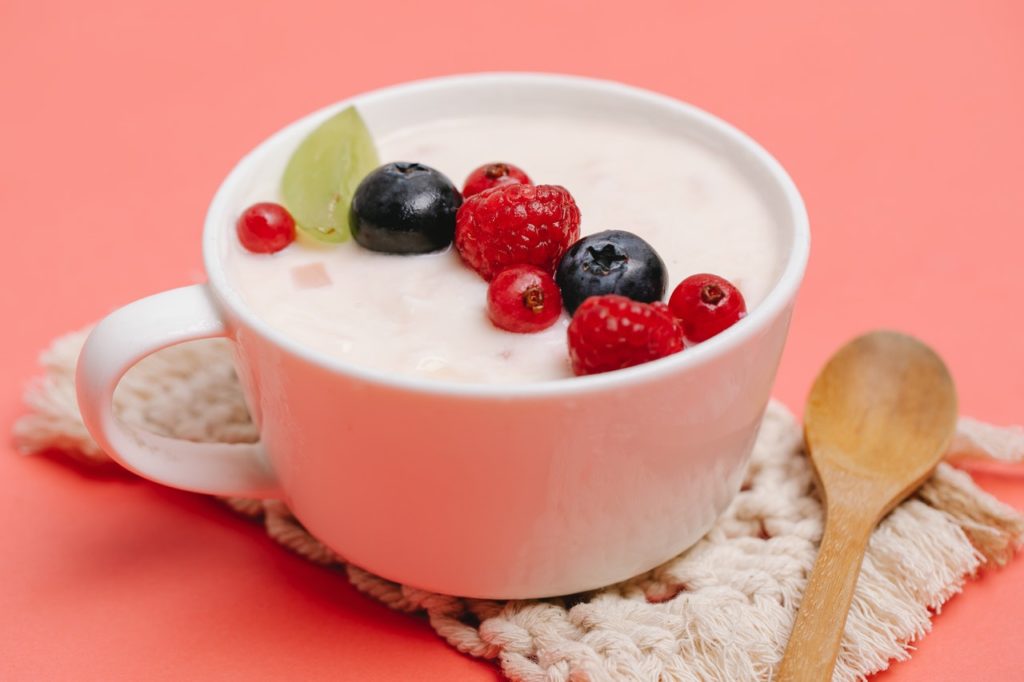
I learned this today. Yogurt is neither a simple liquid nor a solid, it is a non-Newtonian fluid-gel.
A gel is a colloid, and a colloid is a substance that has microscopically dispersed insoluble particles suspended throughout another substance. A non-Newtonian fluid is a fluid that doesn’t follow Newton’s law of viscosity. This means viscosity changes when the liquid is under different stresses.
Yogurt is made when you add bacteria (Lactobacillus delbrueckii ssp. bulgaricus or Streptococcus thermophilus) to milk. If the milk is kept at a warm temperature, the bacteria start to multiply. The Streptococcus thermophilus starts to grow first and creates folic acid and formic acid which the Lactobacillus bulgaricus needs to grow. The Lactobacillus bulgaricus then breaks the milk proteins down into amino acids which the Streptococcus thermophilus needs. They are symbiotic because they both help each other to grow.
The bacteria eat the lactose sugars that are in the milk and transform it into lactic acid. The more lactic acid that is in the milk, the more acidic it becomes. When the milk reaches a certain level of acidity, proteins in the milk called caseins start to clump together. This changes the consistency of the milk and makes it thicker.
The clumps of caseins are suspended in the milk, giving the yogurt its thickness. They are microscopically dispersed insoluble particles suspended in the milk, which is why yogurt is a gel. Gels can trap a liquid inside a solid medium, but they can only hold so much before they are full. This is why some of the liquid leaks out on to the top of the yogurt in the pot. The casein clusters unravel and form a three-dimensional mesh, giving it the properties of a non-Newtonian liquid.
The history of yogurt is long. People probably started drinking milk about 10,000 years ago, after the cow was domesticated. Milk obviously goes bad pretty quickly. Herdsmen in the Middle East carried milk in bags made from intestinal gut and they realized that the milk curdled and soured when it came in contact with the intestinal juices. This curdled milk was preserved and lasted much longer than regular milk and was therefore safer. Yogurt spread to other countries and there are written records of yogurt being eaten in India in 6000 BC. For thousands of years, yogurt was the safest way of keeping milk because the high acidity makes it hard for other bacteria to grow in it.
The word “yogurt” probably comes from the Turkish word “yoğurmak”, which means to thicken, coagulate or curdle. Yogurt came to Europe from Turkey, which is probably why we use a derivative of the Turkish word. Kind Francoise I of France brought it back from Turkey. He was given it as a cure for diarrhea.
Yogurt has medicinal uses and health benefits. It is rich in calcium and potassium. It can lower the risk of numerous diseases. The bacteria have already broken down the proteins in the milk when you eat it, and the calcium and phosphorus have been converted into their soluble form, so it is said to be more digestible. It also replenishes the bacteria that live in your gut. Countries where people eat large quantities of yogurt have long been associated with a longer life expectancy.
So, yogurt is not a liquid or a solid. It is a non-Newtonian liquid because the caseins in it form clumps and unravel into a three-dimensional mesh. This means that the yogurt can sometimes act as a liquid and sometimes a solid, depending on the stress applied to it. It can also be called a gel because the casein clumps are held suspended in the surrounding milk. And this is what I learned today.
Sources
https://www.foodunfolded.com/article/the-chemistry-behind-the-fermentation-of-yogurt
https://en.wikipedia.org/wiki/Lactobacillus_delbrueckii_subsp._bulgaricus
https://en.wikipedia.org/wiki/Streptococcus_thermophilus
https://www.scientificamerican.com/article/bring-science-home-yogurt-bacteria/
https://en.wikipedia.org/wiki/Colloid
https://brodandtaylor.com/blogs/recipes/the-science-of-great-yogurt
https://www.researchgate.net/publication/263440016_Formation_and_Physical_Properties_of_Yogurt
https://academic.oup.com/nutritionreviews/article/73/suppl_1/4/1819293

Pingback: What are the blue bits in blue cheese? - I Learned This Today